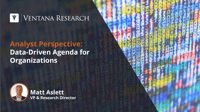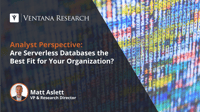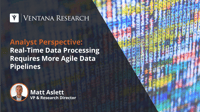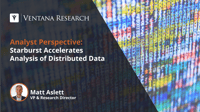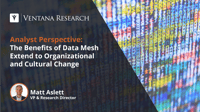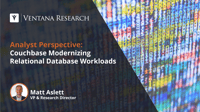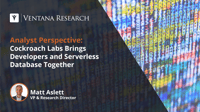When joining Ventana Research, I noted that the need to be more data-driven has become a mantra among large and small organizations alike. Data-driven organizations stand to gain competitive advantage, responding faster to worker and customer demands for more innovative, data-rich applications and personalized experiences. Being data-driven is clearly something to aspire to. However, it is also a somewhat vague concept without clear definition. We know data-driven organizations when we see them...
Read More
Topics:
embedded analytics,
Analytics,
Business Intelligence,
Data Governance,
Data Integration,
Data,
Digital Technology,
natural language processing,
data lakes,
data operations,
Streaming Analytics,
AI & Machine Learning,
digital business,
data platforms,
Analytics & Data,
Streaming Data & Events
The server is a key component of enterprise computing, providing the functional compute resources required to support software applications. Historically, the server was so fundamentally important that it – along with the processor, or processor core – was also a definitional unit by which software was measured, priced and sold. That changed with the advent of cloud-based service delivery and consumption models.
Read More
Topics:
Data,
Digital Technology,
digital business,
data platforms,
Analytics & Data
Over a decade ago, I coined the term NewSQL to describe the new breed of horizontally scalable, relational database products. The term was adopted by a variety of vendors that sought to combine the transactional consistency of the relational database model with elastic, cloud-native scalability. Many of the early NewSQL vendors struggled to gain traction, however, and were either acquired or ceased operations before they could make an impact in the crowded operational data platforms market....
Read More
Topics:
Business Continuity,
Cloud Computing,
Data,
Digital Technology,
digital business,
data platforms,
Analytics & Data
I recently wrote about the importance of data pipelines and the role they play in transporting data between the stages of data processing and analytics. Healthy data pipelines are necessary to ensure data is integrated and processed in the sequence required to generate business intelligence. The concept of the data pipeline is nothing new of course, but it is becoming increasingly important as organizations adapt data management processes to be more data driven.
Read More
Topics:
business intelligence,
Analytics,
Data Governance,
Data Integration,
Data,
Digital Technology,
Digital transformation,
data lakes,
data operations,
AI & Machine Learning,
digital business,
data platforms,
Analytics & Data,
Streaming Data & Events
I recently described the growing level of interest in data mesh which provides an organizational and cultural approach to data ownership, access and governance that facilitates distributed data processing. As I stated in my Analyst Perspective, data mesh is not a product that can be acquired or even a technical architecture that can be built. Adopting the data mesh approach is dependent on people and process change to overcome traditional reliance on centralized ownership of data and...
Read More
Topics:
Business Continuity,
business intelligence,
Analytics,
Data Governance,
Data Integration,
Data,
Digital Technology,
data lakes,
digital business,
data platforms,
Analytics & Data
Data mesh is the latest trend to grip the data and analytics sector. The term has been rapidly adopted by numerous vendors — as well as a growing number of organizations —as a means of embracing distributed data processing. Understanding and adopting data mesh remains a challenge, however. Data mesh is not a product that can be acquired, or even a technical architecture that can be built. It is an organizational and cultural approach to data ownership, access and governance. Adopting data mesh...
Read More
Topics:
business intelligence,
Analytics,
Data Governance,
Data Integration,
Data,
Digital Technology,
Digital transformation,
data lakes,
data operations,
digital business,
data platforms,
Analytics & Data,
Streaming Data & Events
The term NoSQL has been a misnomer ever since it appeared in 2009 to describe a group of emerging databases. It was true that a lack of support for Structured Query Language (SQL) was common to the various databases referred to as NoSQL. However, it was always one of a number of common characteristics, including flexible schema, distributed data processing, open source licensing, and the use of non-relational data models (key value, document, graph) rather than relational tables. As the various...
Read More
Topics:
Business Continuity,
Analytics,
Data,
Digital Technology,
digital business,
data platforms
Breaking into the database market as a new vendor is easier said than done given the dominance of the sector by established database and data management giants, as well as the cloud computing providers. We recently described the emergence of a new breed of distributed SQL database providers with products designed to address hybrid and multi-cloud data processing. These databases are architecturally and functionally differentiated from both the traditional relational incumbents (in terms of...
Read More
Topics:
Cloud Computing,
Data,
Digital Technology,
Digital transformation,
digital business,
data platforms,
Analytics & Data
